

3 reasons for the declining number of Latino physicians
The U.S. Hispanic population has seen significant growth (link is external) in past 50 years, so how is it that fewer Latinos are becoming physicians?
Earlier this year, Latino Leaders Magazine reported on this decline (link is external): a 2015 study, conducted by the Center for the Study of Latino Health and Culture (link is external) at UCLA, indicates that the number of Latino physicians dropped 22 percent over a 30-year period.
1980: 135 Latino physicians per 100,000 Latinos
2010: 105 Latino physicians per 100,000 Latinos…
Link to article
Mexican American Psychology: Social, Cultural and Clinical Perspectives
MA Tovar – 2017 – books.google.com
There are now more than 32 million Mexican Americans living in the United States. As a
result, the odds that a clinician will work with a member of this population—one of the fastest-
growing minority groups in the United States—is extremely high. Understanding the culture…
Link to book preview
Mexican American Proarchive: Annual Report on Mexican American Professionals
News from the census American Community Survey is generally good for the 2015 year. Mexican American college enrollment was up from 18.7% to 18.9% in the 2014 and 2015 years. Graduate or professional degree attainment was also up from 2.9% to 3.0%. The number of bachelor’s degrees granted to Mexican American students rose from 7.6% in 2014 to 7.8% in 2015.


In spite of these gains, Mexican Americans still remain at the bottom of the ladder when it comes to earning a bachelor’s degree. Even after broadening the group to Latinos or Hispanics, this group still lags behind. According to the Pew Hispanic Center: “As of 2014, among Hispanics ages 25 to 29, just 15% of Hispanics have a bachelor’s degree or higher. By comparison, among the same age group, about 41% of whites have a bachelor’s degree or higher (as do 22% of blacks and 63% of Asians).” Pew reports that the main reasons for this low graduation rate is that Hispanics are less likely “to enroll in a four-year college, attend an academically selective college and enroll full-time.”
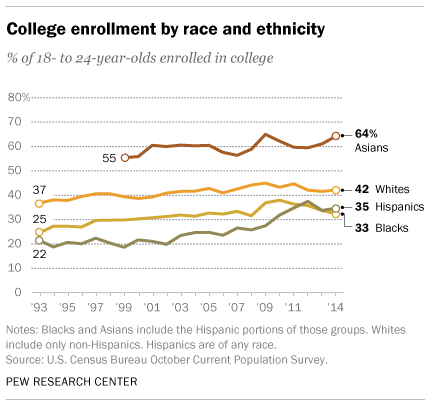
Also in the good news column, the University of California will continue to push for a greater number of underrepresented minorities; namely, Chicano/Latino students whose resident freshmen numbers rose from 2.7% to 32.3% of admitted California freshmen. In other good news, the proportion of Chicano/Latino students transferring from community colleges increased to 29.3% from 26.8% for 2015.
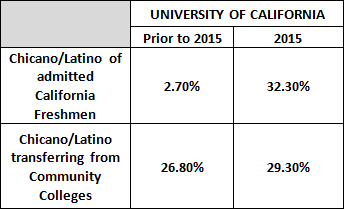
Occupations, including those in management, business, science, and art, fared better for Mexican Americans. The number of Mexican Americans filling these occupations rose from 17.4% in 2014 to 17.5% in 2015.

The total number of Hispanics filling these occupations was 16.1% in 2015, a bit lower than Mexican Americans specifically.
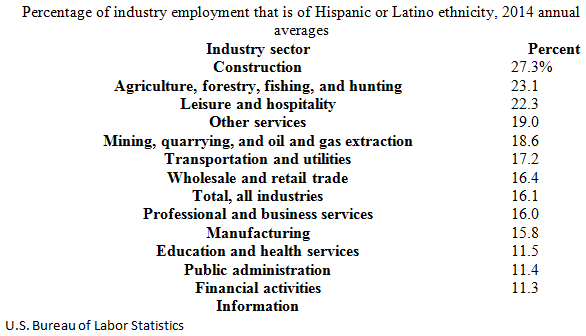
The report shows that industrial employment for Mexican Americans remained the same for 2014 and 2015 at 10.2%.
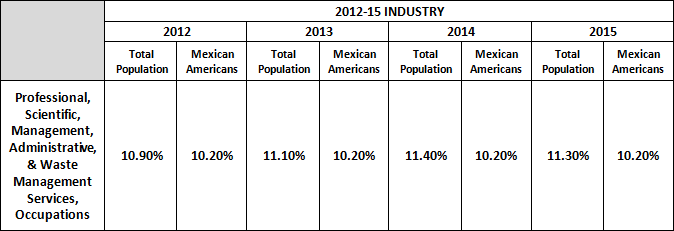
The figures for Hispanic or Latino employment for 2015 and 2016 show a healthy increase.
According to the Pew Hispanic center, “Construction, professional and business services, health services, financial services and food services…showed healthy gains.” Most of the jobs gained by native-born Hispanic workers were in manufacturing, mostly durable goods (82,000 Hispanic workers in this industry), followed by wholesale and retail trade (79,000), publishing, broadcasting, communication and information services (55,000), and construction (54,000).
Foreign-born Hispanics had the most job gains in construction (417,000), followed by business and professional services (179,000). Together, those two industries accounted for almost three-quarters (74%) of all jobs gained by foreign-born Latinos between 2005 and 2006.
The business and professional services sector, which ranges from management and technical services to janitorial, landscaping, and waste management services, is also a key employer for non-Hispanic workers. Of the total increase in employment in 2005-06, non-Hispanic workers accounted for 410,000 employees in the industry, native-born workers 327,000, and foreign-born workers 83,000.
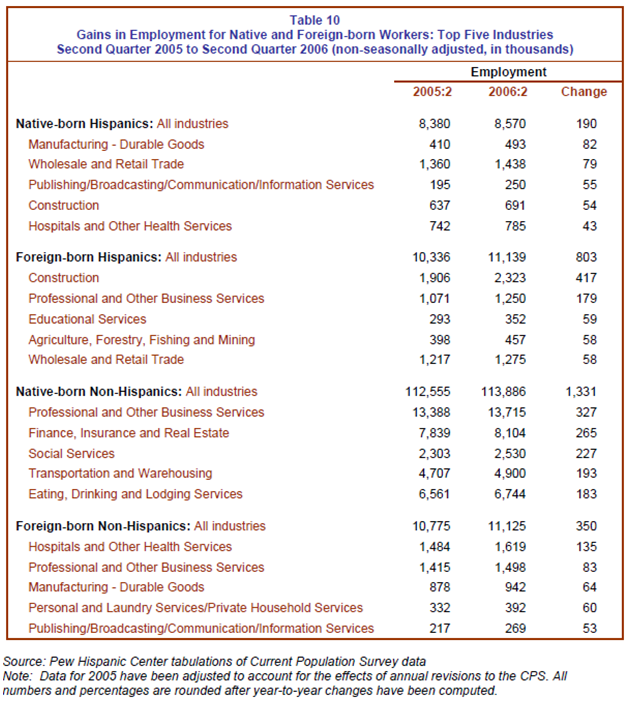
Sources
- Census Bureau, Selected Population Profile in the United States: 2015
- Pew Research Center
- University of California
- Bureau of Labor Statistics
EXPLORING THE LIVED EXPERIENCE OF INTIMATE PARTNER VIOLENCE AND SALUTOGENESIS IN AGING MEXICAN – AMERICAN WOMEN
Intimate partner violence, a serious preventable public health problem affects one in three women in the US and a billion women worldwide, crossing all boundaries including age, ethnicity, religion, and socioeconomic. However, little is known about the experience of IPV in aging women, especially in aging ethnic minorities. Furthermore, there are countless hidden victims including the many children who witness repeated IPV, placing them at risk of becoming a victim of IPV or a perpetrator in their own intimate relationships. The purpose of my dissertation was to explore the lived experience of IPV through the lens of aging Mexican-American women with a history of IPV, to increase understanding of how their experience has shaped their lives today, and to identify the salutogenic factors that may have sustained health in the midst of adversity…
Link to dissertation
Intergenerational Influences in Body Image Among Mexican American Obese Adolescent Females and Their Maternal Caregivers: ¿ Llenita no más ?
YA Marroquin
… Grounded Theory and thematic analysis were utilized to examine interview responses from
Mexican and Mexican American adolescent females with obesity, their … family members, peers
and friends, and medical professionals). In addition, the messages …
Link to dissertation
Transcultural Nursing: Assessment and Intervention
Overview of Mexican Americans
Link to chapter
SALUD, GÉNERO Y EMPODERAMIENTO hiv risk behavior knowledge among Mexican and Mexican American women along the U. S.-Mexico border Implications for health practices in clinical and community settings
BM Mancera, H Mata, LK Robbins… – SALUD
… The role of the fe- male is clearly defined within the Mexican and Mexican American cultures. …
Mental health professionals in El Paso, Texas have reported to us that their caseload of Mexican
refugees and traumatized mi- grants has exploded over the past two years–especially …
Link to study
MEXICAN-AMERICAN WOMEN AND ABORTION: EXPERIENCES AND REFLECTIONS
LB Welter – 2015
… for Meaning-making …..122 and Guidance …..122 Theme 3. Mexican-American Cultural Values …
215 Positive Outcomes from Abortion …..219 Expanded Academic, Professional, and Financial …
Link to dissertation
Racial Disparities in Orthodontic Care for Medicaid -Enrolled Children in Washington
JM Merritt – 2015
… indicative of a class II malocclusion. Whites, Blacks and Mexican Americans had a varying
prevalence of 57.6%, 64.4%, and 66.4% respectively for >2mm overjet.10 Class III malocclusion …
Blacks and Mexican Americans. Racial Disparities in Orthodontic Use for Children …
Link to thesis
The Effect of Bilingualism on Self-Perceived Multicultural Counseling Competence
R Form, TPC More
… Language switching and Mexican Americans’ emotional expression. Journal of Multicultural
Counseling and Development, 35, 154–168. … Counselor bilingual ability, counselor ethnicity,
acculturation, and Mexican Americans’ perceived counselor credibility. …
Link to article
CUIDANDO A LOS NUESTROS: ELDER CARE IN THE CONTEMPORARY LATINO FAMILY
J Medina – 2015
… For many Euro-Americans, there exists little difference between Chicana/o, a Mexican
American, a Central American or a Spanish Caribbean native. … For example, Mexican-
Americans reside in the Southwest (eg, California and Texas); Puerto Ricans …
Link to thesis
Epidemiology of Headache
U Uygunoglu, A Siva – Pharmacological Management of Headaches, 2015
… In the National Health Interview Survey (NHIS), which was conducted by the National Center
for Health Statistics, overall prevalence was estimated as 14.3% in Whites, 14.0% in Blacks, 9.2%
in Asians, 12.9% in Hispanics, 11.9% in Mexican Americans, and 17.7% in Native …
Link to preview
Patterns of Variation in Botanical Supplement Use among Hispanics and Latinos in the United States
KR Faurot, AC Filipelli, C Poole, PM Gardiner – Epidemiol, 2015
… Volume 5 • Issue 3 • 1000195 Epidemiol ISSN: 2161-1165 Epidemiol, an open access journal
US-Mexican border, botanical use may be less common because it is less available. … Loera, 2001,
J Gerontology [22] National cohort study (EPESE), probability, Older Mexican Am. …
Link to abstract
The Effect of Bilingualism on Self-Perceived Multicultural Counseling Competence
NN Ivers, JA Villalba – 2015
… Language switching and Mexican Americans’ emotional expression. Journal of Multicultural
Counseling and Development, 35, 154–168. … Counselor bilingual ability, counselor ethnicity,
acculturation, and Mexican Americans’ perceived counselor credibility. …
Link to article
”
Immigration and psychotic experiences in the United States: Another example of the epidemiological paradox?
H Oh, J Abe, N Negi, J DeVylder – Psychiatry Research, 2015
… association between immigration and PE in the US, and their findings showed that when compared
with native-born populations, Mexican immigrants reported … The NLAAS is a survey of Latino
(n=2554) and Asian (n=2095) Americans, which for the purposes of this study was …
Link to abstract
The Effects of Acculturation on Neuropsychological Rehabilitation of Ethnically Diverse Persons
JP Niemeier, JK Kaholokula, JC Arango-Lasprilla… – … : Clinical Prinicipals for …, 2015
… In terms of pre- dictors for psychological problems such as depression, a recent survey (Leung
et al., 2014) revealed increased self-report of depression symptoms in Mexican Americans who
were concerned about discrimination, had a loss of income, or were worried about …
Link to preview
Binge Drinking and Perceived Neighborhood Characteristics Among Mexican Americans Residing on the U.S.–Mexico Border
PAC Vaeth, R Caetano, BA Mills – Alcoholism: Clinical and …, 2015 – Wiley Online Library
7 days ago – Background This study examines the association between perceived
neighborhood violence, perceived neighborhood collective efficacy, and binge drinking
among Mexican Americans residing on the US–Mexico border. Methods Data were …
Link to article
Stability in Cognitive Function Over 18 Years: Prevalence and Predictors among Older Mexican Americans
Purpose: Numerous studies have examined the association of physical, behavioral and social factors with cognitive decline in older adults. Less attention has been placed on factors associated with long-term maintenance of intact cognition even into very old age. A greater understanding of those factors can inform the development of activities for maintaining cognitive strength. Methods: Using a sample from the Hispanic Established Populations for Epidemiologic Study of the Elderly, a population-based study of non-institutionalized Mexican Americans aged 65 and older from five Southwestern states (N = 2767), latent class mixture models were developed to identify subgroups of cognitive…
Link to abstract
The Association Between Affective and Problem-Solving Communication and Intimate Partner Violence Among Caucasian and Mexican American Couples: a Dyadic Approach
JF Hammett, DM Castañeda, EC Ulloa – Journal of Family Violence, 2015
… Marital conflict and acculturation among Mexican American husbands and wives. …
Professional Psychology: Research and Practice, 40(3), 249–256.View Article; Huston,
TL, Caughlin, JP, Houts, RM, Smith, SE, & George, LJ (2001). …
Link to abstract
Self-Reported Parenting of Clinic-Referred and Non-referred Mexican American Mothers of Young Children
KM McCabe, M Mechammil, M Yeh, A Zerr – Journal of Child and Family Studies, 2015
… Risk, conflict, mothers’ parenting, and children’s adjustment in low-income, Mexican
immigrant, and Mexican American families. … Eyberg child behavior inventory and
sutter-eyberg student behavior inventory-revised: Professional manual. …


